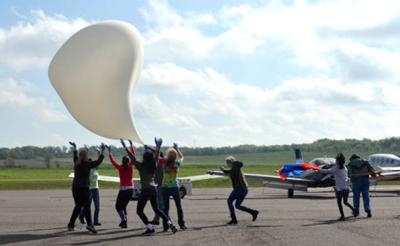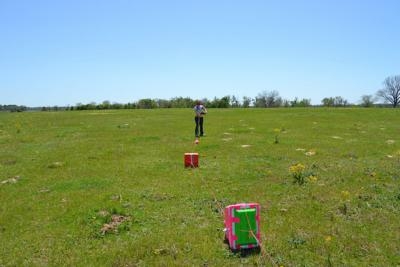BalloonSats Carried To The Fringe Of Earth's Atmosphere
As members of the Women in Aerospace for Leadership and Development (WIALD) student organization launched their payloads from a weather balloon on a windy Texas morning, they bid farewell to Bevo the Dragon, with high hopes that their miniature satellites would be retrieved and intact after landing.

According to a news release on the university website, WIALD members working in two teams spent the fall and spring semesters designing and building BalloonSats – small, simple packages that carry lightweight experiments to the edge of space. The goal of the project was to design, build and test multiple payloads and launch them aboard a weather balloon to over 100,000 feet in altitude. Each BalloonSat contained components including a GPS unit, accelerometer, temperature sensor, data logger and camera. The trial project was designed as a test mission and if successful, could eventually be incorporated into the introductory aerospace engineering course.
The women arrived at Hillsboro Municipal Airport at the break of dawn on April 6 where they began to prepare for launch in the large hangar. They laid out the balloon on a clean surface where they inflated it, prepped all of the payloads and created harnesses to hold them, conducted systems checks and performed a final integration. The payloads were tied together as the balloon was inflated.
Once the group was finally ready to launch, overwhelming gusts of wind began reaching up to 30 mph. Winds were so strong that it took seven women to hold the 50 pound launch unit to the ground. Launch was further delayed by an airplane dropping skydivers overhead. Then, seconds before final liftoff, President Ciara Waldron noticed severe balloon disfiguration and was sure the balloon had popped. Fortunately she quickly discovered that it was strong winds causing the disfiguration – the balloon had not been damaged.
Finally, after all obstacles were overcome, liftoff became a reality. As the balloon whipped around in the gusty winds, the women ran along with it, holding onto their payloads until the entire balloon and all attached payloads were finally carried away into the sky.
Immediately after the launch, WIALD members entered chase mode. Using the payload’s automatic packet reporting system (APRS), Vice President Nicole Pinto and Waldron began tracking the balloon’s position, which was being transmitted through a frequency for amateur radio operators. Nearby amateur operators who were listening in also came out to help them track and locate the balloon.

Nearly an hour later, the payloads landed flawlessly, but their location was somewhat difficult to access. The last packet of APRS data sent was from 3,000 feet, so there was quite a stretch of land to search. First, they suspected it had landed in a lake. Fortunately, that wasn’t the case when they discovered it had landed safely on a patch of green grass between a lake and a river.
There was just one problem – the payloads landed on private property. With a little coaxing, WIALD members were able to gain access to the property from the owners. Team leaders and project managers finally located the balloon – it was laid out so perfectly that when they took photos and sent them to other members, they thought the photo was staged. All of the payloads were in excellent condition.
“This project was our most exciting yet,” Pinto said. “We created everything that went up – procured the balloon, picked the tether line that tied everything together, figured how much helium we needed and more. We designed the entire system ourselves. It was so rewarding.”
After completing the mission successfully, WIALD members believe this project is perfect for the aerospace engineering introductory course.
“This is terrific,” Waldron said. “Participating in a project like this that has such visual and scientific rewards so early in students’ careers will be inspiring. There’s no feeling like launching something into space and getting it returned safely.”
(Images provided by the University of Texas)
 ANN's Daily Aero-Term (05.01.24): Say Altitude
ANN's Daily Aero-Term (05.01.24): Say Altitude ANN's Daily Aero-Linx (05.01.24)
ANN's Daily Aero-Linx (05.01.24) Classic Aero-TV: Korean War Hero Twice Reborn
Classic Aero-TV: Korean War Hero Twice Reborn Airborne 04.29.24: EAA B-25 Rides, Textron 2024, G700 Deliveries
Airborne 04.29.24: EAA B-25 Rides, Textron 2024, G700 Deliveries Airborne Affordable Flyers 05.02.24: Bobby Bailey, SPRG Report Cards, Skydive!
Airborne Affordable Flyers 05.02.24: Bobby Bailey, SPRG Report Cards, Skydive!




